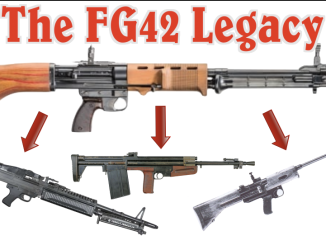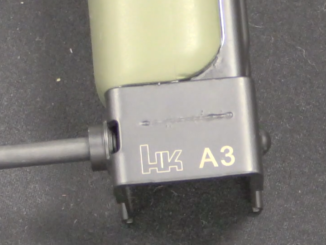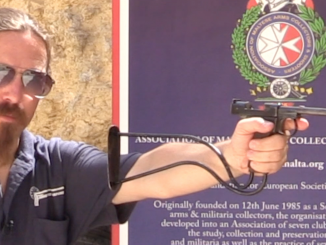George Lanchester was the engineer responsible for originally reverse engineering the German MP28 submachine gun for production by the British, under the designation Lanchester. Once he finished that design work, the gun was put into production by the Sterling Engineering Company, and Lanchester went to work for them as part of the manufacturing process. Once there, he began tinkering with improved designs to reduce the weight of the gun – one of its main drawbacks. He created these three prototypes, but went no father, as government officials ordered him to stop when they discovered this work in 1942. By that time the Sten was in production, and continued development of the Lanchester was seen as a waste of time and resources.
The guns remained in the Sterling company’s reference collection, and elements of the final stock design would resurface in a later prototype design in the 60s. Beyond that, these guns were a simple dead end of design.




The man had talent for “sexy” gun shaping. They carry with them certain kind of attraction, like racy sport cars or motorcycles 🙂
Interestingly at very similar time when G. Lanchester was working on “wood-less” derivative of wooden-stocked sub-machine gun, Hugo Schmeisser was doing opposite work – namely reworking “wood-less” MP40 into sub-machine gun with fixed wooden stock – in this case there was production run and this weapon name is
M.P. 41
PATENT SCHMEISSER
C. G. HAENEL, SUHL
For photos see: https://modernfirearms.net/en/submachine-guns/germany-submachine-guns/mp-41-schmeisser-eng/
Good reminder. In fact, on psychological level, in past soldiers were able to relate more closely to personal weapons with wooden stocks. For example, Czech soldiers from period between wars used to talk about their rifle as – trying phonetically – “brzhiza”(birch). I think it is cute.
Apparently intended for Romania. Supplemented the numbers of Orita SMGs produced there for the Romanian army being rather roughly handled by the Soviets on the Eastern Front…
Also in Soviet Union, even after start of production of PPS, there were some tries to make lightened (without wood) version of PPSh – see left-upper quarter of first image from top here: https://www.thefirearmblog.com/blog/2017/08/10/rare-experimental-versions-soviet-ppsh-submachine-gun/
Hmmm, but what you do if you want to swat someone real good or break door; PPSh with wooden stock has no match. It will do it every time and shoot after doing it.
The grips on the first and second one appear to be made out of…well, I’m not sure what they would’ve had in 1942, but it resembles the modern G10. Some kind of cloth-based laminate material. Anyone know more specifically what it is/might be?
First and third one, I meant to say.
Micarta maybe?
I’d agree, or even plain unreinforced Bakelite or another phenolic resin. The high-gloss lustre and velvet or wood-grain figuring we see here are typical for resin products of the time.
Ive seen that material somewhere, I think thats some kind of not casted but machineable plastic
“(…)government officials ordered him to stop when they discovered this work in 1942(…)”
Wait. So who actually ordered enlightened sub-machine gun from G. Lanchester? Was it private venture Sterling Engineering Company or government order?
Anyway, one prototype looks for me as mimicking MP38 or MP40 – especially looking at stock and barrel without jacket. Which lead to my wondering when British captured first sample of that German sub-machine gun and what was opinion about it?
During war time, every private or corporate activity in UK was under auspices of government, so much more weapon production industry. You can be sure they had jurisdiction over such ‘minor’ things like small arms. Heck, people even could not slaughter a pig without gov’t permission; there was an excellent comedy movie made about it.
Here are reviews of movie Private functions:
https://www.imdb.com/title/tt0089838/reviews
“Very good, typical British comedy’, says one of them. I agree, I loved it.
Wait, so how it is possibly that according to https://augfc.tumblr.com/post/180752195685/the-vesel%C3%BD-v42-this-submachine-gun-was-designed
(…)there was no interest in Veselý’s new design(…)Veselý paid out of his own pocket to produce a prototype in 1942(…)
?
Yeah, that is weird, but I gather this was part of “foreign engineering weapon research department” dominated by Poles. I do not recall reading about this “czek” creation.
You can’t really say that it was a dead-end development. After all, Lanchester’s work at Sterling led to Patchett’s work there, and the result was the Sterling machine carbine (SMG) that replaced the Sten.
Looking inside an L2 of any subtype, its MP28/Lanchester ancestry is pretty obvious. Lanchester and Patchett basically modernized the MP28 for mass production, with stampings and etc. wherever possible.
In the process, they eliminated most of the drawbacks of the MP28 without really adding any new ones.
cheers
eon
Yes, your first paragraph is right on. It ended with an excellent Sterling SMG. Definitely not work in vane.
From the Sterling SMG came the Spanish Star Z-62/70 with the magazine housing at the bottom, so it still proves that the Lanchester SMG wasn’t a dead end line.
Stock looks cool, but its sides plate profile does not promise good for the cheek.
Sterling has inverted U shaped piece, that looks more rounded and cheek friendly.
Reversing the barrel would be necessary as the Lanchester barrel is threaded into the muzzle end of the cooling shroud. Having cut that off in the quest for lightness, he had to reverse the barrel and cut a new thread into the end of the shortened receiver.
“(…)1942(…)Sten was in production, and continued development of the Lanchester was seen as a waste of time and resources(…)”
Interestingly STEN would later evolve in Lanchester-y direction, as Mk.V would sport wooden stock and bayonet mount
https://modernfirearms.net/en/submachine-guns/great-britain-submachine-guns/sten-eng/
Beyond that there was ROFSTEN prototype:
https://guns.fandom.com/wiki/ROFSTEN
Oh, and I would forget about another Lanchester-y STEN prototype, see 1st photo from top:
https://augfc.tumblr.com/post/99082566260/wooden-sten-an-experimental-sten-mkiii-fitted
The MK.V usually lost its vertical foregrip pretty quickly in service, as the mount was weak and it tended to literally be broken off. This never bothered the Tommies much, as they were accustomed to wrapping the left hand around the barrel jacket and letting the magazine rest on the left forearm while shooting, anyway.
The Resistance liked the Sten Mk. II best of all. It could be broken down into four sections (barrel, receiver, stock, magazine) for transport and concealment, with the longest piece being the receiver;
https://scontent-lga3-1.cdninstagram.com/vp/6f13f4a2bf389eccdf5bd8f191ac1cc5/5D954F28/t51.2885-15/e35/47582722_240676223519713_7305149054410172272_n.jpg?_nc_ht=scontent-lga3-1.cdninstagram.com
It could be hidden in spaces that would not accommodate the other versions, notably the MK.III in which the receiver and barrel jacket were a single piece;
https://modernfirearms.net/userfiles/images/smg/smg27/sten_mkIII.jpg
Plus, any MK. II could be fitted with a sound suppressed barrel, either supplied by SOE or “home-made”:
https://images-na.ssl-images-amazon.com/images/I/912hMkb4IbL.jpg
You just unscrewed the standard barrel and screwed the suppressed barrel on instead.
The MK. III may have been the Sten produced in the greatest numbers because it was the simplest to make. But the MK. II was probably the all-around best variant in actual use.
cheers
eon
@eon: Actually, it was the Sten MkII that was produced in the greatest numbers. The reason? Because the barrel was pinned and pressed into place on the MkIII, damage to either the receiver or the barrel entailed scrapping the entire weapon, while the Sten MkII could have either a new barrel attached as snazzily as you indicate, or a new receiver tube added.
I have this for production numbers for the MkIII, mostly based on Laidler:
Close to a million of this variant (876,886) were manufactured by Lines Brothers, producers of “Tri-Ang” sheet metal toy cars and lorries at “The Largest Toy Factory in the World” from the spring of 1942 through the autumn of 1943. From the point of view of industry and ease of manufacture, this SMG was the epitome of simplicity, using a sheet of metal cut out on a template, pressed or stamped into shape around a mandrel, and the top seam spot-welded along the top rib to which the rudimentary sights were attached. The two drilled holes behind the front sight allowed for attachment of a simple carry sling. The barrel could not be removed since it was pinned and welded in place. Also unlike the Mk. II, the magazine housing was immovable. Thus, rather than supply of a new barrel or replacement receiver in case of damage to either unit, the entire weapon had to be scrapped. It was for that reason production of it ceased in favor of the Mk. II and Mk. V. A design element brought back from the original wood-stocked Mk. I and metal-stocked Mk. I* was the inclusion of a metal hand guard (that nonetheless conducted considerable heat after firing a few magazines) with a finger stop riveted just forward of the ejection port in an attempt to prevent injury to the fingers of the support hand via straying into the port and bolt raceway. The cheapest Sten submachine gun variant to build, provided stamping machinery was available (most post-WWII guerrilla, insurgent, paramilitary, and/or criminal copies were of the seamless tubing reliant Sten Mk. II) vying with Soviet designs such as the Sudayev PPS-43 7.62x25mm in relative ease and simplicity of manufacture. It was the lightest Sten variant. Officials intended the Mk. III to become the standard machine carbine of the Home Guard in 1943 until it was stood down in late 1944, but the model was widely used by the army as well.
Barrel trunnions in mk.III were actually pinned and soldered.
British sten production mark is imppressive, but Stens combat record is under utilized, compared to ppsh or mp40, and I believe vast majority of them were in warehouses and never issued, also how many enemy casualties they inflicted in comparison to beforementioned 2 smgs, probably very low. (and small arms in general were responsible for small percent, artillery inflicts 70-80% of casualties, which is understandable as its not easy to hit somebody unless hes standing idly in the open “medieval battle style”, or its in the close quarters).
Only in the event of british isles invasion Stens would show their real practice and worth, and pay off all the effort that went into their production – but that does not mean they, and home guard would not end up similar to deutsche volksturm.
As for the smg that was ultimate in cost effectivness of production, it was m3 grease gun, once you set up the stamping factory, no sten is close to cheapness it could yield in mass, millions piece production.
As many operations that in sten would be welded, drilled, milled etc. in m3 were accomplished in just 2 stampings, it even did away with cocking handle. But, if you do not master the stamping and subsequent joining technology and precision in that, you could get complete catastrophe and not 1 in 10 guns working.
The Home Guard was actually far more “combat capable” than the Volkssturm, self-deprecating humor about “Dad’s Army” notwhithstanding… Admittedly, from June 1940 until quite some time later it was in a deplorable state, and the weapons situation was a true emergency.
The Sten Mk.II was the most widely manufactured variant.
The German MP.3008 Volksmaschinepistol simplified things even more than the pinned and soldered/ spot welded Sten Mk.III! The sheet of steel was bent around a mandrel, and the seam typically ran along the area of the bolt-handle raceway and the ejection port, being closed with welded in bits of metal. It came out far too late to make any difference in the ultimate fate of the so-called “Thousand Year Reich.”
The original M3 had a crank on the side for use as a non-reciprocating charging handle. It was, as you note, replaced with a simple finger slot in the bolt. The M3’s have the nifty system whereby the bolt rides the two rods and does not contact the sides of the receiver tube like on the Sten. If only General Motors and U.S. industry had decided to build SMGs in 9mm and with a more reliable magazine than the Sten for all the Allies, no? That would have been something, even if just a lowly individual infantry weapon and not a larger and more prominent weapon system… Think the “Sherman tank” of SMGs…
“(…)m3 grease gun(…)”
And how does it compare in regard of production time to Soviet PPS-43?
Agree about the Home Guard.
Volksturm were leftovers of the leftovers, to paraphrase the quote about how german ww2 drink Fanta came to be.
Pps3 is cheaper to start production, but still too many operations.
But here we can chime in regional difference, maybe pps43 was cheaper than m3, as the government making them underpaid, or did not pay at all, as compared to factory workers making m3 in the USA.
For the same nefarious reason you today (last 30 years) have most consumer goods from electronics to clothes and basicly everything made in asiatic countries like China, Pakistan, Vietnam, Bangladesh etc.
There 95% of workers will never see a retirement fund that couod yield them enough money to travel around the world, like what japanese or western europe and usa retired people have, after a life of hard work.
@Daweo: Well… Certainly the PPS-43 was among the best of the WWII-era SMGs, and quite cheap to make. But why no standardized magazine between it and the 35rd. magazines for the Shpagin PPSh41? And apparently there wasn’t much parts interchangability or magazine compatibility within PPSh41 production either! Admittedly, this was a supreme wartime emergency, but the U.S. had parts interchangeablility–the American method of production–with the 1842 percussion musket! And within a factory, the 1819 Hall breech-loader…
The M3 is also modular, easily converted to 9mm. So it would be an excellent multinational weapon, as to Dave’s point. But too late. Now a PPSh in .45 Auto would have been a hell of a thing to load onto all those freighters coming back from the USSR after delivering Lend-Lease, in 1942 when the US was the Ally having submachinegun issues.
Very interesting as the french gun magazine Cibles in their patent section has just done a three part series on the various Patchetts
The third part in the june issue starts the article with the following statement
At the end of ninteen forty three the ordinance board stopped the smg trials and decided to wait till after the war to adopt a new machine carabine however a certain amount of experimentation continued on some models such as the Pratchett machine carabine